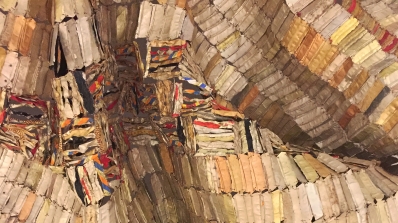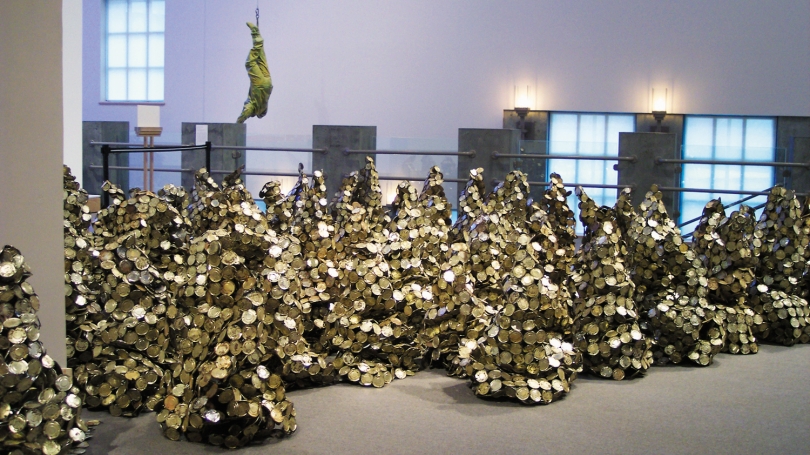Communal Creations: The Art of El Anatsui
"Art grows out of each particular situation, and I believe that artists are better off working with whatever their environment throws up." —El Anatsui, 2003
El Anatsui uses found objects to celebrate Africa's rich artistic and cultural heritage while commenting on broader concerns in Africa today, particularly the adverse effects of globalization, cosumerism, and waste. The exhibition El Anatsui: GAWU features the Hood's recent purchase Hovor (2003), a spectacular work made from discarded aluminum seals of liquor bottles gathered in and around Nsukka, Nigeria, where the Ghanaian artist lives and works. With the assistance of many people in his immediate surroundings, El Anastui wove flattened seals together with copper wire, transforming a recycling project into a monumental finished "cloth" that directly mimics the Ghanaian strip-woven cloths, called kente, that were historically worn by the Akan king and his royal court as regalia.
The following is an interview excerpted from the exhibition's catalogue:
Gerard Houghton (GH): To make something [this large] over what must have been a long period obviously required quite a team of people to help you?
El Anatsui (EA): It's a terribly laborious process. In a day you are talking about maybe half a square foot. Apart from my full-time studio staff, I have assistance from some of my students and largely from young men within the vicinity of my studio, especially when they are on holidays. On a particularly full day, we could be up to fourteen pairs of hands spread out in the studio.
GH: So each person would work on his or her own piece, or would several people work on a single piece together?
EA: No, each person would work on a separate segment and then afterwards would come my major intervention of putting these together.
GH: So you have a whole group of people working together to create a single piece of material—it's an interesting model of communal creation.
EA: It is a universal approach. I think the form lends itself to this kind of strategy.Working on such a large scale alone can quickly become very boring. Also variety, which is needed at this scale, could come from the style and the feel of each individual hand: on occasion, for instance, when we had to fold and twist the flattened tops before sewing, there were many effects and styles of folding/twisting from each individual, resulting in the variety of textures.
GH: One of the things that interests me about these pieces is that the material seems to have the same essential qualities as any piece of cloth, the way it hangs and can be draped like woven textiles.Yet at the same time you know, intellectually, that it's made of metal, something rigid and unyielding, and that there's a sensual opposition set up between what the eye sees and what the mind knows.
EA: Yes, this idea of getting a fabric out of metal, it's interesting to me in the sense that the idea of hardness/rigidity is subverted by having the medium treated that way. Well, and this idea of using drinking tops too. Back home, we would characterize someone who is given to the pleasures of drinking and eating as someone who is "building in the stomach," so that kind of idea is somehow behind it as well—the whole piece is talking about "consumption," or could be seen as referencing it at least. Not consumption as something that is peculiar, in the sense that we are talking about the various landscapes that consumption can create in Nigeria, Ghana, etc. You can have huge piles of detritus from consumption, because you don't have the technology to recycle and also because of weather. A lot of things which are made in Europe and America and are sent over, arrive in certain kinds of packaging, for example fresh milk comes in tins. We have our own milk too, of course, but in addition there are huge imports of milk from outside, which is accessed by way of tins. Being that you don't have the means to recycle, there develop huge piles of milk tins, drink tops, and all these things all over the place. So it's an examination of consumption and the various landmarks it can generate in various parts of the work.
The illustrated exhibition catalogue El Anatsui: GAWU was published by Oriel Mostyn Gallery, Llandudno,Wales, in 2003. Gerard Houghton is a writer and linguist at the October Gallery, London. The catalogue is available at the Hood Museum Shop. El Anatsui will speak at the Hood on January 10.
El Anatsui: GAWU is on view from January 6 through March 4. The presentation of this Oriel Mostyn Gallery touring exhibition at the Hood Museum of Art, Dartmouth College, is generously funded by the George O. Southwick 1957 Memorial Fund and the Hansen Family Fund.
Related Exhibitions:
- El Anatsui: GAWU
- Modern and Contemporary Art at Dartmouth: Highlights from the Hood Museum of Art
- In Residence: Contemporary Artists at Dartmouth
- More exhibitions of Modern & Contemporary Art

